-
19
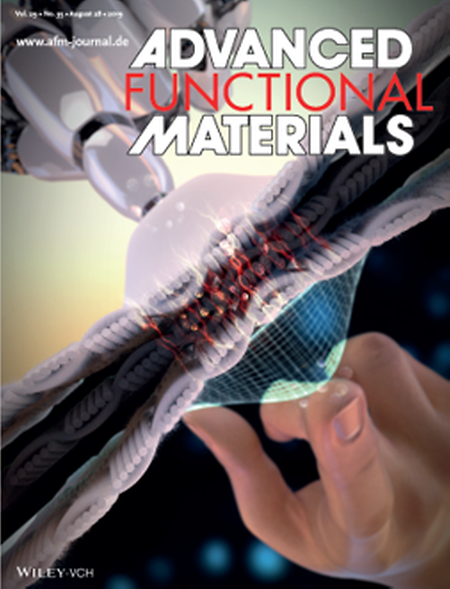
- 융합공학저널 'Advanced Functional Materials' 논문 게재 및 표지 논문 선정
- 융합공학저널 'Advanced Functional Materials' 논문 게재 및 표지 논문 선정 기계공학과 김종백 교수 연구팀이 개발한 유연 촉각 센서 연구가 세계적인 융합 공학 저널인 ‘Advanced Functional Materials' (Impact Factor: 16.836, 상위 3.98%)에 게재되었으며, 그 연구수월성을 인정받아 해당 저널 2019년 29권 35호의 표지논문 (Front cover)으로 선정되었다. 본 논문에서는 다층 구조의 직물을 활용한 유연 촉각 센서를 제시하며, 이를 생체 신호 모니터링과 촉각 인터페이스 시스템으로 활용이 가능함을 보였다.
- 기계공학부 2021.04.16
-
18
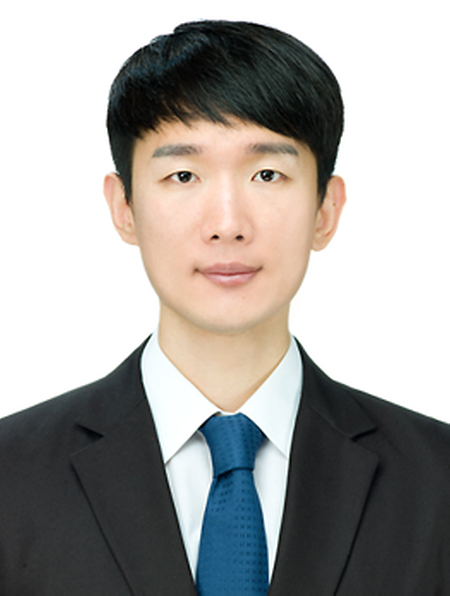
- 표순재 박사, 서울과학기술대학교 전임교수 임용
- 표순재 박사, 서울과학기술대학교 전임교수 임용 기계공학과 김종백 교수 연구실에서 박사 학위를 취득하고 동 연구실에서 박사후 연구원을 지낸 표순재 박사가 2020년도 3월 서울과학기술대학교 기계시스템디자인공학과 교수로 임용되었다. 표순재 박사는 기계공학과 BK 사업단의 박사후 연구원으로 재직하는 동안 Adv. Funct. Mat., small, Sens. Actuators B Chem. 과 같이 높은 평가를 받는 저널을 포함하여, 다수의 최상위급 SCI 논문들을 출판한 바 있다.
- 기계공학부 2021.04.16
-
17
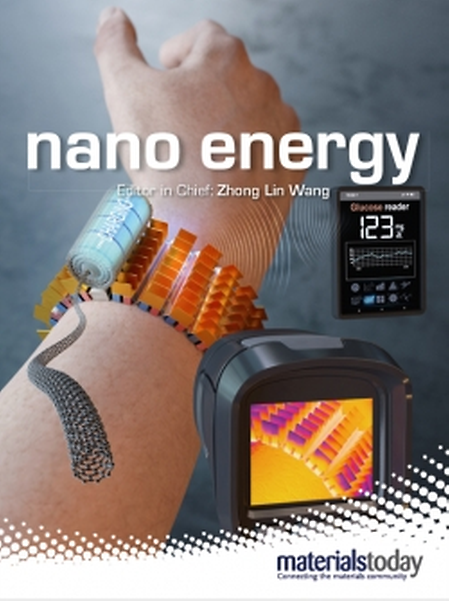
- 'Nano Energy' 저널 79권호 출간 논문 Back Cover 선정
- 'Nano Energy' 저널 79권호 출간 논문 Back Cover 선정 김우철 교수 연구팀의 논문인 "Self-charging wearables for continuous health monitoring"이 우수성을 인정 받아 'Nano Energy' 저널(Impact Factor: 16.6, JCR 상위 5%)의 Back Cover로 선정되었음 (Nano Energy 79, 105419 (2021)). 이번 논문은 웨어러블 열전소자와 리튬-황 배터리를 결합해 상용 연속혈당측정기를 안정적으로 작동할 수 있음을 실증하였다. 본 논문은 김우철 교수(교신저자)가 지도하고, 제1저자인 김지용학생과 Salman Khan학생이 주도하였다. [언론보도] 2021.01.25 / e-대학저널: http://www.dhnews.co.kr/news/articleView.html?idxno=135740 2021.01.26 / 테크월드: http://www.epnc.co.kr/news/articleView.html?idxno=114579
- 기계공학부 2021.04.16
-
16
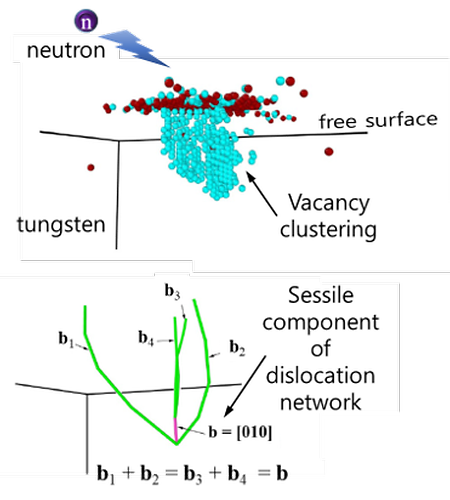
- 핵융합 저널 'Nuclear Fusion'에 논문 게재
- 핵융합 저널 'Nuclear Fusion'에 논문 게재 강건욱 교수 연구팀의 논문인 "Free-surface effect on displacement cascades in BCC W: molecular dynamics study"이 세계적인 핵융합 저널인 Nuclear fusion (IF:3.706, JCR 상위 8.82%)에 게재되었다. 이번 논문은 분자 동역학 시뮬레이션을 이용하여 텅스텐 표면 부근에서의 조사 결함 메커니즘 규명에 대한 논문이다. 해당 연구는 핵 융합로 대면재로 사용되는 텅스텐에서 조사 결함의 생성 및 성장 메커니즘을 확인하였으며, 이를 조사 손상 최소화를 위한 텅스텐 합금 설계에 적용할 수 있다는 점에서 큰 의의를 가진다. 본 논문은 강건욱 교수(교신 저자)가 지도하고, 제 1저자인 이형규 학생이 주도하였다.
- 기계공학부 2021.04.16
-
15
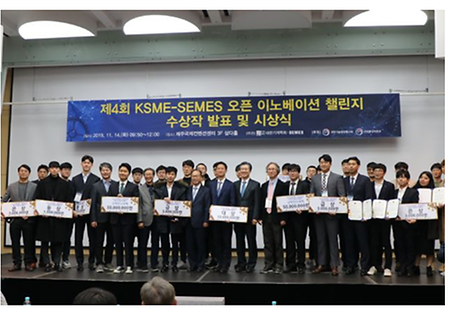
- 이형석 교수 연구팀, 대한기계학회-SEMES 오픈이노베이션 챌린지 대상 수상
- 이형석 교수 연구팀, 대한기계학회-SEMES 오픈이노베이션 챌린지 대상 수상 이형석 교수 연구팀에서는 '음향파를 이용하여 액체 속 미세 입자를 조작하는 기술'을 연구 개발중이다. 반도체 및 디스플레이 제작 과정에서 생성되어 공정 정밀도를 낮출 수 있는 ‘미세 버블’을 음향파로 제거하는 기술에 대한 제안으로 ‘제4회 대한기계학회-SEMES 오픈이노베이션’ 공모전에서 대상을 수상했다. SEMES는 삼성전자 자회사인 반도체 제작 장비 업체이다. [언론보도] 2019.11.15 / ZDNet: https://zdnet.co.kr/view/?no=20191115110855&re=R_20201221150403
- 기계공학부 2021.04.13
-
14
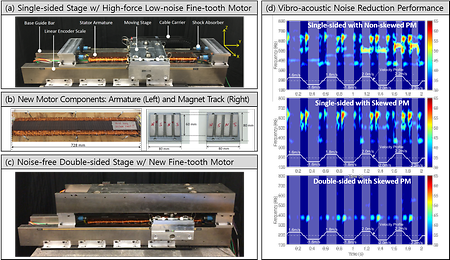
- Novel Motor for Next-Generation Semiconductor Photo-Lithography Systems
- Novel Motor for Next-Generation Semiconductor Photo-Lithography Systems Professor Jun Young Yoon in the Department of Mechanical Engineering at Yonsei University has worked with MIT researchers to design and develop a new motor for high-precision high-throughput next-generation EUVL (Extreme Ultra-Violet Lithography) systems. While commercially available linear iron-core synchronous motors have the potential for high thrust, they can emit significant vibrations and acoustic noise, thereby impairing accuracy of high-precision manufacturing systems such as in photo-lithography machines, also known as semiconductor chipmakers. Professor Yoon and his co-workers 1) found, for the first time, root causes of such vibro-acoustic noise emitted by linear iron-core permanent magnet motors, 2) proposed and validated a new motor magnetic design, called a fine-tooth motor, to reduce the noise while increasing thrust performance compared with conventional linear motors, and 3) further reduced the noise through a double-sided mechanical configuration of the new fine-tooth motors. The work has been published in multiple journals and conferences including IEEE Transactions on Industrial Electronics (TIE) and IEEE/ASME Transactions on Mechatronics (TMECH). For his research accomplishment, Professor Yoon won the ‘Young Engineer Award’ from the Korean Society for Precision Engineering (KSPE) and the ‘Young Scientist Award’ in the 2019 ASML Korea Tech Talk, which is also covered in media (links provided below). “We hope our new magnetic and mechanical solutions of high-force low-noise linear motors for the EUVL help the semiconductor industry pushing the limits even further to make our everyday lives faster, easier, and smarter“, says Professor Yoon. [Associated Publication] Yoon, J.Y., Lang, J.H. and Trumper, D.L., Fine-tooth iron-core linear synchronous motor for low acoustic noise applications. IEEE Transactions on Industrial Electronics, doi: 10.1109/TIE.2018.2835416 Yoon, J.Y., Lang, J.H. and Trumper, D.L., Double-Sided Linear Iron-Core Fine-Tooth Motor for Low Acoustic Noise and High Acceleration. IEEE/ASME Transactions on Mechatronics, doi: 10.1109/TMECH.2019.2929236 [Media Coverage] THEELEC: http://www.thelec.kr/news/articleView.html?idxno=2751 KIPOST: https://www.kipost.net/news/articleView.html?idxno=201782
- 기계공학부 2020.08.26
-
13
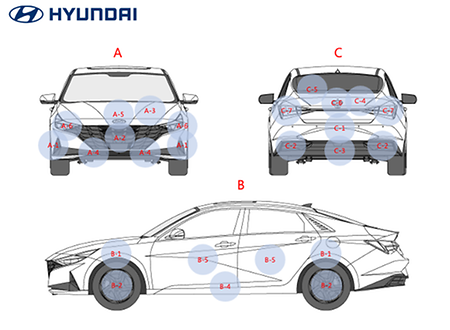
- Vibration & sound power reduction of a thin plate-like structure excited by complex inputs
- Vibration & sound power reduction of a thin plate-like structure excited by complex inputs Many engineering structures are composed of plates and plate-like components, such as the outer casing of a washing machine, printed circuit boards (PCBs) in electronic devices, the ship hull and deck. These structures are vulnerable to complex inputs, combination of force and moment components, from vibrational sources such as motors, pumps, and collision between parts. The resulting vibration and noise emissions jeopardize the integrity of the engineering structure. Yonsei research team led by Professor No-Choel Park in the school of Mechanical Engineering proposed a new method for reducing the vibration and sound radiation of a thin plate excited by complex input sources. A set of new formulas for the sound radiation of baffled and unbaffled plates are derived by substituting the moment components of the plates with the equivalent couples using finite difference analysis. This approach allows to calculate sound power purely by the input location and amplitude of each component. Thus, it enables faster, more accurate calculations than the existing methods such as the average radiation efficiency analysis and the radiation mode analysis. The results of the research were published in Journal of the sound and vibration with the title “Calculation and reduction of sound radiation from a thin plate structure excited by complex inputs”.
- 기계공학부 2020.08.26
-
12
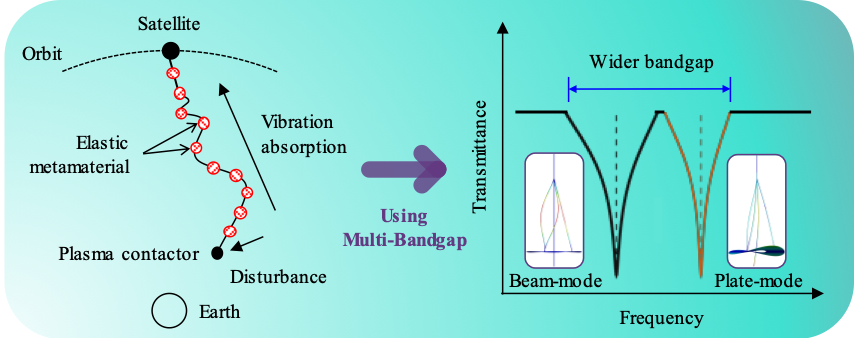
- Vibration absorption of space tethers using pendulum-type elastic metamaterial
- Vibration absorption of space tethers using pendulum-type elastic metamaterial Professor No-Cheol Park in Mechanical Engineering and his research team have designed pendulum-type elastic metamaterials for vibration absorption of space tethers. Space tether is highly exposed to external disturbances such as meteoroid collisions. Disturbances are transmitted to the satellite via tether cables and affect the satellite's orbit and posture. The pendulum-type elastic metamaterial absorbs vibration propagating through the resonance of the internal structure. In addition, his research team proposed a method to absorb vibrations over a wider frequency range using multi-bandgaps. The results of the research were published in the International Journal of Mechanical Sciences in July 2020 with the title “Experiment and analysis of a space tether with pendulum-type elastic metamaterials” and Korea patent with the title “Satellite tether device using elastic metamaterial” has been registered.
- 기계공학부 2020.08.26
-
11

- Replacing batteries with supercapacitors
- Most batteries we use on a daily basis are rather inefficient. Rechargeable lithium batteries – like the one on your phone – take long to recharge and have short cycling lifetimes. This is detrimental to the environment and ultimately expensive. Supercapacitors have the ability to store static electricity between two oppositely charged plates, and they have the benefit of being faster and more durable. However, the energy density (or amount of energy that can be stored per unit volume) of most supercapacitors is still considerably lower than most batteries. This is related to the capacitance of the supercapacitor, which depends on the material of the electrodes. Researchers have experimented with negative electrodes made of molybdenum dioxide (MoO2) nanostructures, which could provide a high specific capacitance, but these are limited by slow kinetics and volume change upon cycling. This impedes electrochemical stability and leads to rapid degradation upon cycling. Rechargeable batteries degrade rapidly, charge slowly, and have harmful environmental consequences. This is why supercapacitors could be the next big revolution in electronics. (Photo courtesy: Shutterstock) To solve this problem, a group of researchers led by Prof. Seong Chan Jun, have designed a tubular nanostructure of MoO2 combined with nitrogen-doped carbon hybrids (MoO2@NC) as the negative electrode. The hollow nature of the structure provides a higher surface-to-volume ratio for the charge to distribute, enhancing its electrochemical performance. At the same time, the N-doped carbon enhances the electrolyte transportation of the material. This was synthesized along with a copper cobalt sulfide (CuCo2S4) structure as the positive electrode to complete the supercapacitor. This resulted in a supercapacitor that performed significantly better than those previously reported in the literature. The flexible, hollow carbon substrate provided a large surface area that was also better able to alleviate volume change during cycling, improving electrical conductivity. The structure achieved what the author Prof. Jun described as an “ultrahigh”energy density of 65.1 W h kg -1 at a power density of 800 W kg -1. Approximately 90.6% of the initial specific capacitance was retained after 5000 cycles, and after 2000 bending cycles, the device exhibited 92.2% retention. “Developing more efficient ways to store energy could significantly change the way we interact with electronics”, says Prof Jun. Flexible supercapacitors could make wearables more user-friendly. They are better for the environment, and lighter in weight. Because they can deliver and accept significantly faster than batteries, affordable and smaller supercapacitors have the potential to change the electric car industry. Link to the paper Updated in August 2019
- 기계공학부 2020.06.27
-
10
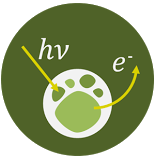
- Nanoelectrode System Developed to Extract Electricity from Algae
- A research team led by Professor Won-Hyoung Ryu has created a technology to extract photosynthetic electrons from algae Yonsei Mechanical Engineering Professor Won-Hyoung Ryu’s research team has created a technology to extract photosynthetic electrons from algae. Their method involves inserting a patterned nanowire or nanoelectrode into live algal cells, enabling the potential harvesting of electricity from multiple cells simultaneously. The team reported on this new energy conversion technology in the September 14, 2016 issue of Advanced Functional Materials, an important journal in the field of materials engineering. Of the research, Professor Ryu said: “The system we developed this time is a new concept of bio-solar energy conversion technology that uses algal cells, which have recently come to the fore as an environmental issue. This technology’s development is the product of a study that showed the possibility of the practical use of photosynthetic currents, and it further shows the possible development of bio-solar energy hybrid energy conversion technology.” Updated in Feb 2017 Reference Kim, L. H., Kim, Y. J., Hong, H., Yang, D., Han, M., Yoo, G., Song, H. W., Chae, Y., Pyun, J.-C., Grossman, A. R., Ryu, W., “Patterned Nanowire Electrode Array for Direct Extraction of Photosynthetic Electrons from Multiple Living Algal Cells” Advanced Functional Materials, doi: 10.1002/adfm.201602171
- 기계공학부 2020.06.27

